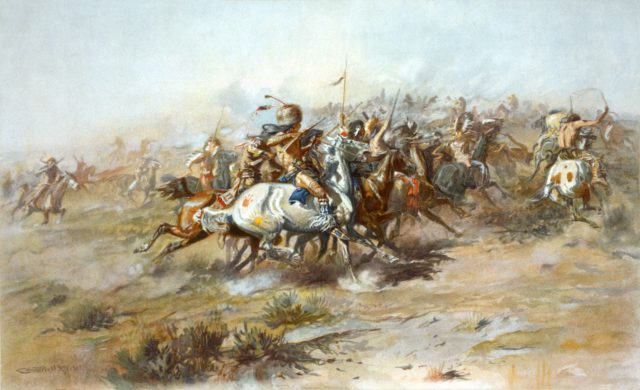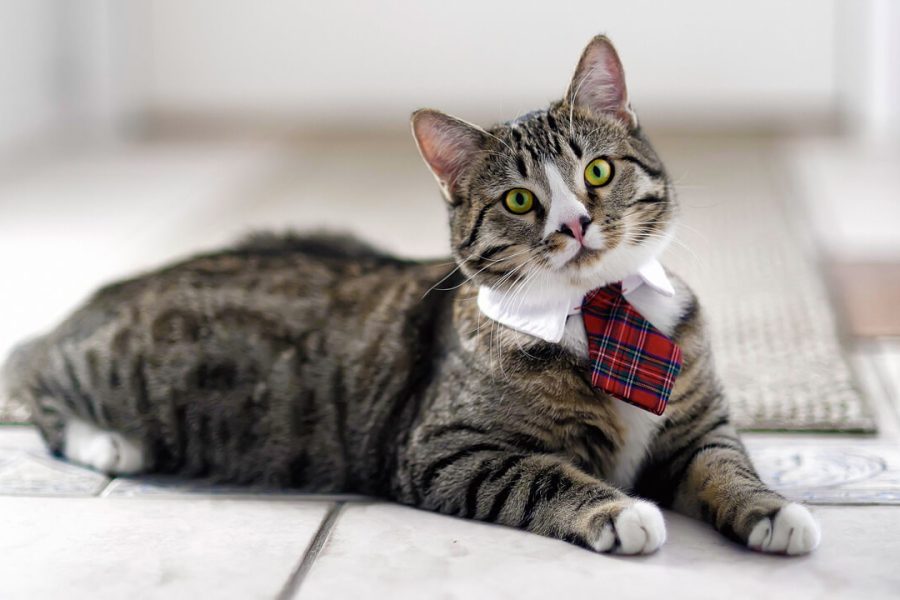There is no shortage of animal heroes today, from service dogs who care for their owners to those who serve in police, fire, and military forces around the world. Many animals of the past were heroes, and in their time, even celebrities. In some cases, they became famous because of their owner’s fame. In other cases, they became famous because of their own exploits.
Latin phrase Sic Transit Gloria Mundi, « "So passes the glory of the world," is sometimes paraphrased as "all glory is fleeting." Certainly, that phrase applies to the animals listed here, all of whom were honored in life, though their stories are known to relatively few today. Here are ten memorable animals that were hailed as heroes in life, and why.
10. Copenhagen, the racehorse who became a war hero

Copenhagen was a half-Thoroughbred, half-Arabian stallion whose maternal grandfather had won the 1793 Epsom Derby. In 1811, Copenhagen began a racing career in which he had little success and lasted only two seasons. In 1813, the five-year-old stallion was sent to Lisbon as part of a consignment of horses for the use of British officers, and later that year was purchased by Colonel Sir Alexander Gordon. Gordon purchased the horse for the commander of the British forces during the Peninsular War with Napoleon in Spain, Sir Arthur Wellesley.
Wellesley then held the title of Marquess of Wellington, as his brother Richard, also a Marquess, retained the family name in his title. Wellington found Copenhagen an exceptional horse in battle and in travel. It was said that Copenhagen would not allow anyone to ride him, and from time to time he even kicked Wellington. As Wellington's fame grew, so did his horse's, and his mane and tail were trimmed so that his hair could be made into ornaments. the battle of waterloo Wellington remained in Copenhagen for 17 hours, and his praise of the horse added to its fame.
Wellington continued to ride in Copenhagen for victory parades and other events until the horse was retired to the Duke's estate at Strathfield Stay, where he enjoyed sugar cakes and other delicacies until his death at the age of 28. The Duke buried him in Strathfield . He later claimed not to know where the horse was buried. Years later, a headstone was erected near the spot where it was believed to have been buried. He is immortalized in equestrian statues of the Duke of Wellington and in many paintings of the Duke on horseback in battle.
9. Montauciel, the sheep who flew in a hot air balloon.

The Montgolfier Brothers Joseph-Michel and Jacques-Etienne were the first balloon experimenters, although they believed it was smoke, which they believed contained a gas they called Montgolfier gas, that made their balloons rise. In 1782, they proposed to King Louis XVI that they use their balloons as a means of storming the British fortress of Gibraltar. The king agreed to allow a demonstration, but at that time no living creature other than birds had risen to what they then considered the "upper layers of the atmosphere" (about 1,600 feet). The brothers proposed launching a rooster, a duck, and a sheep. The latter was chosen because its internal anatomy was thought to be similar to that of a human. The birds, which were expected to be unharmed, served as controls in the experiment.
So, on September 19, 1783, in the presence of King Louis and Queen Marie Antoinette, as well as Benjamin Franklin, the sheep became the first a mammal that rose into the sky in a man-made vehicle. The brothers named the sheep Montauciel, which is French for "to rise to the sky." He flew about two miles at an altitude of about 1,500 feet and landed safely. Montauciel was unharmed by his experience, and the king agreed to further demonstrations of flight, with the brothers taking turns piloting the balloon. Jacques-Etienne went first, making him the first person to fly in a hot air balloon.
Marie Antoinette was smitten with Montauciel, and to further ingratiate herself with His Majesty (they needed money), her brothers gave her sheep. She kept them in the gardens of Versailles and allegedly fed candies and other sweets At the time, sheep were a common sight on the palace grounds as they mowed the lawns while grazing, so Montauciel probably had many sheep.
8. Simon, the ship's cat on HMS Amethyst .
Ships have used cats as mascots for centuries to entertain crews and, more importantly, to help control rodents. Some have become famous, including Unsinkable Sam, who supposedly survived the sinking of three ships. Simon, the ship's cat on HMS Amethyst in the late 1940s, received the Dickin Medal for his heroism on board ship during its deployment to China during the Chinese Civil War. Ordered to Nanking to protect the British Embassy from Communists, "Amethyst" came under fire on April 20 1949, while still traveling up the Yangtze River. About 22 of his crew were killed and several more were injured, including Simon, seriously enough that he did not survive.
Simon suffered lacerations and several burns, but was cared for by the ship's medical staff after the crew was treated. He eventually returned to duty, helping to combat the ship's worsening rodent problem. April 30 to July "Amethyst" could not leave for Hong Kong without being shot at by Communist weapons. Months of negotiations to free the ship proved fruitless. The long stay in the river led to an increase in rodent infestation, threatening the dwindling food supplies. Once he had regained his health, Simon remained busy. Finally, on July 30, "Amethyst" slipped away under cover of darkness, eluded communist batteries and returned to Hong Kong. There Simon's story has come to light to the world.
The ship's captain, Lt. Bernard Skinner, was killed in the attack. On April 21, Lt. Cmdr. John Kerans arrived from the British Embassy and took command of the ship through its ordeal and escape. Kerans was no fan of the cat when he came aboard. Simon changed his mind. He recommended Simon to Dickin Medals, and when the award was confirmed in August, the team made Simon a collar in the colours of the award ribbon. He was officially due to receive the award on 11 December, after Simon had completed quarantine upon his arrival in the UK in November. Sadly, Simon died of enteritis in late November. He was given a full naval funeral and buried in the PDSA (People's Dispensary for Sick Animals) cemetery in Ilford. To date, Simon is the only cat to have been awarded the Dickin Medal, often referred to as the Victoria Cross for service animals.
7. Comanche Survivors of Custer's Last Stand

Comanche was a 15-hand mixed-breed gelding purchased by the U.S. Army in 1868 for use as a cavalry mount. At Fort Leavenworth, Kansas, Captain Miles Keogh encountered the horse and bought her from the army to serve as his personal mount . Kio served in the 7th cavalry regiment, a newly formed unit commanded by Lieutenant Colonel George Armstrong Custer. Keogh was mounted on a Comanche when he rode with Custer at the Battle of the Little Big Horn in June 1876. When the bodies of Custer's men were discovered by troops under General Alfred Terry, they found the badly wounded horse on the battlefield, two days after the battle. The Comanches were taken to Fort Lincoln, nursed back to health, and retired.
His retirement order stated that Comanche "...will not ride with anyone under any circumstances, nor will he be compelled to do any work." Comanche was used in formal regimental cavalry formations, saddled, bridled, and dressed in mourning clothes for the rest of his life. He lived to be 29, according to estimates of his age when he was purchased by the Army in 1868. Upon his death, he was buried with full military honors, although his horse was not interred. .
Instead, he was sent to the University of Kansas, and taxidermists preserved his body for display. He's still there,glass display case with adjustable temperature and humidity at the University of Kansas Museum of Natural History. Comanche is often cited as the only member of the U.S. Army under Custer to survive the Little Big Horn, and the only cavalry horse to survive the battle. Neither is true, although it is true that he is the only veteran of the battle today, so to speak.
6. Antis, the German Shepherd Who Helped Bomb Germany
Czechoslovakian Air Force pilot Vaclav Bozdech fled his home country for Poland when Hitler annexed the Sudetenland in 1938. From Poland he made his way to France, where he served in the French Air Force until it became apparent that France was about to fall to the Germans in 1940. While there, he either found or bought a German Shepherd puppy ( his later stories vary ). He shipped the puppy to the UK , when he fled to the country, evading British quarantine laws. He joined the Royal Air Force, and the dog joined him, living on the base. Bozdec, assigned to fly a Wellington bomber, was on a flight when he discovered the dog had "hidden" in the plane. At the end of the mission, the crew credited the dog, whom his owner named Antis, with bringing them luck.
So, despite it being against the rules, Antis became part of a crew, usually of six people. In the case of Bozdek's Wellington, it was There were six people and a dog. Antis flew 30 missions during the war before his illegal practices were discovered. After the war, he returned to Czechoslovakia with his master. When the Soviet Union made it clear that Czechoslovakia was to become a communist puppet state, Bozdeč fled again, leaving his wife and child behind but taking his dog with him, which helped him evade Soviet and Czech secret police and border guards and cross the border into West Germany. From there, he went again to England with Antis. He never returned to Czechoslovakia.
After the war, the story became widely known German Shepherd flying with the bombers Germany, including the fact that Antis was twice wounded by flak. Antis was recommended for the Dickin Medal, which Field Marshal Archibald Wavell pinned to his collar in 1949.
5. Enos, the only chimpanzee (so far) orbiting the Earth.

Enos is not as famous as Ham, the first chimpanzee to fly into space and returned to Earth. Ham's fight was suborbital and lasted only about fifteen minutes. Because his flight was longer, Enos required more extensive training than Ham and was exposed to weightlessness for a longer period of time. Enos's flight was far from trouble-free, and after only two of the three planned orbits, NASA aborted the mission, although the chimp returned safely to Earth and was recovered.
Enos, like Ham, was trained to press levers in response to light patterns and received a small electric shock to the soles of his feet if he did not respond correctly or at all. During the flight, Enos sometimes responded correctly, only to receive a shock due to a glitch in the system. An occasionally frustrated chimpanzee pressed various combinations of levers only to receive more shocks. In total, Enos received 78 shocks during the flight, almost all due to system failure. His capsule also overheated, increasing the animal's discomfort. Finally, NASA decided to shoot him down early.
Enos's troubles were not over. His capsule splashed down far from where his Earth controllers were expecting him, and Enos was forced to wait out the wait in the raging ocean while the fleet came for him. While he waited (for over three hours), Enos ripped his suit and tore apart his biosensors, as well as his urinary catheter, with an understandable expression of disgust. Enos died of dysentery less than a year later. after his space flight. NASA officially reported it to newspapers and other media as a success.
4. Sgt. Reckless, USMC

Sergeant Reckless was a Korean mare of Mongolian breeding purchased by the US Marines from a South Korean groom at a racetrack. in Seoul in 1952 . The Marines intended to use it as a packhorse for a platoon of 5-mm recoilless riflemen. go Marine Regiment. The mare was allowed to roam freely around their camp and became known for her willingness to eat almost anything put before her. Along with her Marines, she also learned to drink both Coca-Cola and the beer the soldiers provided. And she showed exceptional intelligence.
Sergeant Reckless learned the route from the front lines to the supply depots in just one or two trips with her handler. Then she would make the trip on her own, freeing her handler to perform other duties. On one day of heavy fighting, Sgt. Reckless made 51 solo flights , resupplying Marines on the front lines. She often carried the wounded on the return journey as well. She received two Purple Hearts after being wounded twice during the war, and was later awarded the Good Conduct Medal. She also received the Dickin Medal, the Navy Commendation, and numerous other awards.
After the war, she remained in the Marines, spending much of her time at Camp Pendleton, where she often snacked on her own blankets, a tendency she also demonstrated in Korea. Reckless retired from the Marines in 1960, and in lieu of retirement benefits, she accepted free room and board. Few Marines were allowed to ride her during her career, though it did legendary Marine Chesty Puller , and later the foal she produced was named Chesty in his honor. Sgt. Reckless died in 1968. She is commemorated by several monuments in the United States and South Korea, and also in Marine Corps lore .
3. Kaiser, the longest held prisoner of war in American history.

The Kaiser was German carrier pigeon, captured by the Americans at the end of World War I. After the war, the bird, which his American captors named Kaiser, was brought to the United States. After being used for publicity purposes for a while, Kaiser was given a job that probably had never been offered to a prisoner of war before or since. He was sent to the Pigeon Communications Center at Fort Monmouth in New Jersey.
To the Kaiser assigned to serve as a breeding pigeon Despite the onerous nature of his duties, Kaiser clearly carried out his duties with enthusiasm. After the United States entered World War II, Kaiser carried out his duties at Camp Crowder, Missouri. By then, he had numerous descendants who served on every front where American troops fought during the war. During the war, Kaiser, who lived with his girlfriend, Lady Belle, enjoyed a private loft that the Army had thoughtfully equipped with a heater for the cold Missouri nights. More than 75 pigeons born to Kaiser were adopted by the Signal Corps during World War II, indicating that he took his duties seriously despite his German heritage.
Kaiser died on October 31, 1949. It is virtually impossible to determine the number of pigeons his offspring produced for the U.S. Army, which disbanded its pigeon service in the late 1950s. But his heroic performance of one's duties during World War II led to his preservation in the Smithsonian Institution along with other heroic pigeons of his era. He must have loved his job, because he is the longest-lived homing pigeon on record, living for over 33 years. He was also the longest-serving American prisoner of war in the country's history.
2. Judy, the only dog captured during World War II.

Judy was the ship's mascot aboard HMS Grasshopper when the ship attempted to leave Singapore at the start of the Pacific War in 1942. The ship was sunk en route to the Dutch East Indies, and the survivors, including Judy, attempted to escape overland but were captured by the Japanese and imprisoned in Medan. There, British POW Frank Williams convinced the Japanese commandant to treat Judy, a purebred pointer, as with a prisoner of war. Miraculously, the commandant agreed, and Judy became the only dog to be registered as a prisoner of war during World War II. Like other British prisoners, Judy was kicked and beaten by Japanese guards, but survived.
Judy apparently came and went from the camp at will, as she gave birth to two litters of puppies during her incarceration. In 1944, Williams and 700 other prisoners were shipped to Singapore. Williams smuggled Judy aboard. When the ship was torpedoed by a British submarine, Williams and Judy survived. , but were separated for a time. By 1945, Judy had become more aggressive towards the Japanese, and they decided to shoot the dog. Judy escaped from the camp into the jungle and returned only after the Japanese guards left the camp.
After the war, Frank Williams put Judy on a troop ship bound for Liverpool. After the latter used publicity to raise funds to pay the quarantine fees, Judy was quarantined and finally handed over to Frank in the UK in April 1946. She became a celebrity, met the actor David Niven, and was feted in cities around the UK. She then travelled with Frank to East Africa. There, it was discovered that she had a tumour, which was removed surgically, but the infection proved too severe. She was euthanised in 1950. In May 1946 Judy was awarded the Dickin Medal "For outstanding courage and endurance in Japanese prisoner of war camps..."
1. Rin Tin Tin, one of the first international action heroes

The original Rin Tin Tin was a newborn puppy when he found by an American soldier in France During World War I, a soldier, Corporal Lee Duncan, discovered five puppies and their mother, the puppies so young that their eyes had not yet opened. The mother was emaciated. After nursing the mother back to health and weaning the puppies, Duncan kept one puppy of each sex. He named the male Rin Tin Tin, though he named the female dog Rinty, and named his sister Nanette. He smuggled both puppies onto a ship that took him back to the United States. Nanette developed pneumonia, and Duncan replaced her with another Shepherd puppy in New Jersey before traveling by train across the United States to California.
Duncan trained both dogs himself. In 1922, Rin Tin Tin played his first film role, playing a wolf in the silent film " The Man from Hell River " The following year he appeared as a star in the film "Where the North Begins" . Rin Tin Tin became a major action hero on the big screen, popularizing the then little-known German Shepherd breed in the United States. Because the films had no dialogue and could be shown overseas simply by changing the credits to the appropriate language, Rin Tin Tin became a global superstar, popular on five inhabited continents.
He had just ventured into sound films when he died in 1932, aged 13 or 14, depending on the source. Radio networks interrupted their programming to announce the news. Obituaries and assessments appeared in newspapers and national magazines. By the time of his death, he was being played on screen by his sons and grandsons. He was buried in Duncan's Los Angeles backyard and later reinterred in the Cemetière des Chiens in Paris, France, the country of his birth. His descendants continue to portray his persona using his name to this day.













Оставить Комментарий